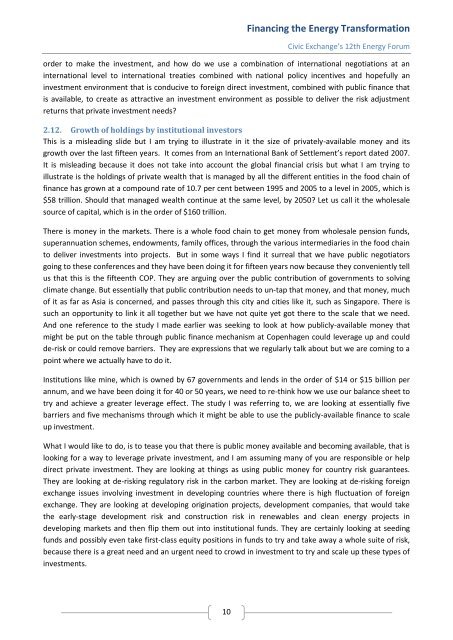Financing the Energy Transformation - Civic Exchange
Financing the Energy Transformation - Civic Exchange
Financing the Energy Transformation - Civic Exchange
You also want an ePaper? Increase the reach of your titles
YUMPU automatically turns print PDFs into web optimized ePapers that Google loves.
<strong>Financing</strong> <strong>the</strong> <strong>Energy</strong> <strong>Transformation</strong><strong>Civic</strong> <strong>Exchange</strong>’s 12th <strong>Energy</strong> Forumorder to make <strong>the</strong> investment, and how do we use a combination of international negotiations at aninternational level to international treaties combined with national policy incentives and hopefully aninvestment environment that is conducive to foreign direct investment, combined with public finance thatis available, to create as attractive an investment environment as possible to deliver <strong>the</strong> risk adjustmentreturns that private investment needs?2.12. Growth of holdings by institutional investorsThis is a misleading slide but I am trying to illustrate in it <strong>the</strong> size of privately-available money and itsgrowth over <strong>the</strong> last fifteen years. It comes from an International Bank of Settlement’s report dated 2007.It is misleading because it does not take into account <strong>the</strong> global financial crisis but what I am trying toillustrate is <strong>the</strong> holdings of private wealth that is managed by all <strong>the</strong> different entities in <strong>the</strong> food chain offinance has grown at a compound rate of 10.7 per cent between 1995 and 2005 to a level in 2005, which is$58 trillion. Should that managed wealth continue at <strong>the</strong> same level, by 2050? Let us call it <strong>the</strong> wholesalesource of capital, which is in <strong>the</strong> order of $160 trillion.There is money in <strong>the</strong> markets. There is a whole food chain to get money from wholesale pension funds,superannuation schemes, endowments, family offices, through <strong>the</strong> various intermediaries in <strong>the</strong> food chainto deliver investments into projects. But in some ways I find it surreal that we have public negotiatorsgoing to <strong>the</strong>se conferences and <strong>the</strong>y have been doing it for fifteen years now because <strong>the</strong>y conveniently tellus that this is <strong>the</strong> fifteenth COP. They are arguing over <strong>the</strong> public contribution of governments to solvingclimate change. But essentially that public contribution needs to un-tap that money, and that money, muchof it as far as Asia is concerned, and passes through this city and cities like it, such as Singapore. There issuch an opportunity to link it all toge<strong>the</strong>r but we have not quite yet got <strong>the</strong>re to <strong>the</strong> scale that we need.And one reference to <strong>the</strong> study I made earlier was seeking to look at how publicly-available money thatmight be put on <strong>the</strong> table through public finance mechanism at Copenhagen could leverage up and couldde-risk or could remove barriers. They are expressions that we regularly talk about but we are coming to apoint where we actually have to do it.Institutions like mine, which is owned by 67 governments and lends in <strong>the</strong> order of $14 or $15 billion perannum, and we have been doing it for 40 or 50 years, we need to re-think how we use our balance sheet totry and achieve a greater leverage effect. The study I was referring to, we are looking at essentially fivebarriers and five mechanisms through which it might be able to use <strong>the</strong> publicly-available finance to scaleup investment.What I would like to do, is to tease you that <strong>the</strong>re is public money available and becoming available, that islooking for a way to leverage private investment, and I am assuming many of you are responsible or helpdirect private investment. They are looking at things as using public money for country risk guarantees.They are looking at de-risking regulatory risk in <strong>the</strong> carbon market. They are looking at de-risking foreignexchange issues involving investment in developing countries where <strong>the</strong>re is high fluctuation of foreignexchange. They are looking at developing origination projects, development companies, that would take<strong>the</strong> early-stage development risk and construction risk in renewables and clean energy projects indeveloping markets and <strong>the</strong>n flip <strong>the</strong>m out into institutional funds. They are certainly looking at seedingfunds and possibly even take first-class equity positions in funds to try and take away a whole suite of risk,because <strong>the</strong>re is a great need and an urgent need to crowd in investment to try and scale up <strong>the</strong>se types ofinvestments.10
















